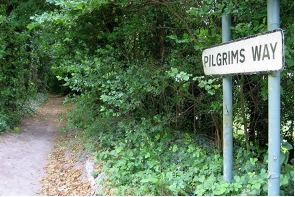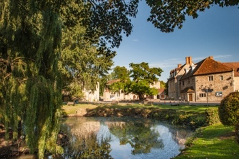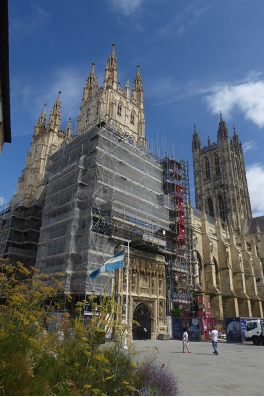
Pilgrims Way Pilgrimage
This is a digest of the WhatsApp pilgrimage on the Pilgrims Way in Kent on 7th and 8th September 2024. The format of the pilgrimage was such that pilgrims could drop in and out during the journey, spending as much time as was practical. This meant that people in different time zones could still participate fully.
(Note that, in the interest of brevity, the WhatsApp dialogue generated during the pilgrimage has not been included.)
The route wasn't any old Pilgrims Way, it was the one made famous by Geoffrey Chaucer in his book The Canterbury Tales, written in Middle English in the 14th century. In the book, the pilgrims make the 85 mile journey from the Tabard Inn at Southwark, south London, down through the county of Kent to visit the shrine of Saint Thomas a Becket in Canterbury Cathedral.
Chaucer has the host of the Tabard Inn propose a story-telling contest between the pilgrims which subsequently provides the material for the book. On our contemporary pilgrimage we were part of a new story that we created together as we virtually travelled down to Canterbury. To do so, we followed the Four Steps of Pilgrimage (click here for more on the Four Steps.)
1. Holy Longing
“Examine yourselves”, 2 Corinthians 13.5
Your pilgrim journey begins with new thoughts or experiences that are in some way challenging, or a desire to examine a specific Scripture.
Obviously, part of the planning was to establish to route. Ours took us from London, in the top left-hand corner of the map, eastward through Kent to arrive at Canterbury which is near to the centre.
On the way, as we left the capital, we saw many historic sites and famous landscapes, notably the iconic chalk North Downs which eventually lead to the White Cliffs of Dover.
But we also spent some time reflecting on the nature of pilgrimage itself. So, in the picture, which are the tourists? And which are the pilgrims? On the surface it may be hard to tell the difference.
Really, it is not the outside that counts, rather it is the motivation from within. One definition is that "tourists see what they have come to see" and there is nothing wrong with that. However "pilgrims see what they see"; pilgrims try to journey with an attitude of openness, to see where the Holy Spirit is leading.
I think there were both pilgrim and tourist elements to our journey; after all, it was billed as going to Canterbury Cathedral so you might have been miffed to find yourself at the Tower of London! However, a journey becomes a pilgrimage when, in tandem with being a tourist, we use the time to explore more deeply into God’s Word.
As the picture says, we should prepare beforehand, not on the day we start out.
I suspect that, if you habitually dress like the people in the picture, you are probably good at preparation. However, it is not only helpful to know where you are going, but also why.
As we said, we only change from tourists to pilgrims when we sense that we are journeying towards God. There is a saying “Those that travel across the sea, change only the sky above their heads, if they do not change their souls.”
With the above in mind, we used the journey intentionally to meditate on a passage of Scripture.:
“And we all, who with unveiled faces contemplate the Lord’s glory, are being transformed into his image with ever-increasing glory, which comes from the Lord, who is the Spirit.” 2 Corinthians 3.18
This needs to be read in the wider context of the book, but the verse gave us a very powerful focus for our journey, as we “with unveiled faces contemplate the Lord’s glory.” The prayer was that, in the power of the Holy Spirit, our souls would be changed through our journey together.
2. Pilgrim Journey
“Set your heart on pilgrimage”, Psalm 84.5
During your journey, mediate on the Bible verses you are reading as you review and reflect on your thoughts and experiences.
This step is an opportunity to look for anything new or perhaps inconsistent with previous experience and understanding.
The following are some commentary and a very few images from Day One of the journey through Kent to Canterbury.
Welcome as we venture out along the Pilgrims Way from London to Canterbury. Historically the route was established after the martyrdom of Thomas a Becket in 1170. As Archbishop of Canterbury, he was murdered in his cathedral after quarrelling with King Henry II. After this event, which shocked European Christendom, Thomas was quickly canonised.
He acquired a reputation as a healer and over the following centuries hundreds of thousands came to his shrine from all over Europe. The shrine was destroyed in the 16th century, and pilgrimage for a while was forbidden. These days, pilgrims make the journey for reasons other than physical healing. Nevertheless. the story remains a powerful motivating focus for the journey.
The starting place for Chaucer’s pilgrims was the Tabard Inn at Southwark, south London. This has long since been demolished so we started from Southwark Cathedral. In different forms, this has been a site of Christian worship and community for over 1000 years. In the background is The Shard skyscraper, an iconic London landmark.
Lullingstone Roman villa, about 20 miles from London. Of great interest to us, there is very strong evidence that, in the fourth century AD, the inhabitants of the villa converted to Christianity. Only about 300 years after Christ’s earthly ministry, a house-church was established at what had previously been a pagan shrine. For example, archaeologists pieced together a Chi-Rho, an early Christian symbol formed by the first two letters of Christ’s name in Greek, chi (χ)and rho (ρ).
A beautiful view of a landscape known as The Weald, about 30 miles from where we started. You are looking out from the chalk North Downs, across an area of clay, sandstone and green sand.
Aylesford Priory, on the river Medway near Maidstone. The priory was founded in 1242 when members of the Carmelite order arrived in England from Mount Carmel in the Holy Land. They were dispossessed in the 16th century Reformation but ownership was restored in 1949. It has become, amongst other things, a centre for artwork and also an important pilgrim destination.
The picture shows one of the Stations of the Cross panels created by Adam Kossowski (1905 – 1986). He was a Polish Roman Catholic artist who arrived in Great Britain in 1943, a refugee from a Soviet labour camp. He promised that “if I came out of this subhuman land, I would tender my thanks to God. I hesitate to call it a vow, it was rather a promise to myself.” He fulfilled that promise to his art and was very involved in the artistic refurbishment of Aylesford Priory.
Day one finished at Harbledown, not much more than a mile and a half from Canterbury’s West Gate. The picture shows the Black Prince’s Holywell in the grounds of what was originally a leper colony, now almshouses.
Perhaps fewer Christians today go to holy or healing wells to receive cures, but we still seek God and it is worth reflecting on where we are looking as we journey through life.
Day Two of the pilgrim journey was spent exploring Canterbury. In the picture you find yourself looking down Mercury Lane with a glimpse of the main cathedral gateway at the end. But what does it mean, practically for us whilst we are still here on Earth, to glimpse ”the Lord’s glory” with “with unveiled faces”?
We used the Six Practices of 24-7 Prayer to help us answer the question.
The Practice of Creativity
Enjoying and expressing God’s presence through colourful, generous and imaginative lives.
Canterbury Cathedral is full of stained glass from different periods of church history. A beautiful way of telling stories that evolved when literacy was less widespread.
The Practice of Hospitality
Cultivating generous space for others in our hearts and homes, as if they were Christ Himself in our midst.
Eastbridge Hospital, founded in the 12th century, was a hospital in the old sense of the word, short for “hospitality.” It provided overnight accommodation for poor pilgrims who were travelling to the shrine of Saint Thomas a Becket.
The Practice of Mercy and Justice
Honouring God’s presence in the poor and oppressed, through sacrificial compassion, reconciliation and advocacy.
The picture shows the Cathedral’s “Chapel of Saints and Martyrs” where more modern martyrs are remembered. Amongst numerous others, the following are inluded: Edith Steir, a nun who was executed in Auschwitz in 1942 and who had been a source of inspiration and hope to those around her. The Christian civil rights leader, Martin Luther King, assassinated in 1968. And the priest Arastoo Sayyah-Sina, murdered in Iran in 1979. All totally committed to mercy and justice.
The Practice of Mission and Evangelism
Demonstrating God’s presence and relevance in word and deed, wherever He currently seems to be absent or ignored.
Pope Gregory had a deep desire to bring the Gospel to the English people. He was in the marketplace in Rome where there were some fair-haired English slave-boys from England. Gregory was told they were pagan Angles (from which we get the word England) and he responded “Not Angles but Angels.” Subsequently, he commissioned a monk called Augustine to undertake the task in 597. Aided by Queen Bertha, wife of Saxon King Ethelbert, Augustine began his ministry from his base in Canterbury.
The picture shows a modern statue of Gregory with the Angles, on the St Thomas of Canterbury Roman Catholic Church.
The Practice of Learning and Discipleship
Worshipping with all our minds and developing disciples who can carry Christ’s presence powerfully into every sphere of society.
The picture shows the Cathedral’s cloisters, an important part of medieval monasteries and cathedrals. It is here that the monks would have meditated, studied and exercised. The cloisters have open sides looking onto the inner quadrangle, but it is also roofed, so there was plenty of light and also shelter.
The Practice of Prayer
Celebrating God’s presence in all things, at all times, through a daily rhythm of prayer and worship.
There are very many places within the Cathedral that are conducive to prayer, as well as in other churches in the city. But of course, prayer doesn't have to be in a religious setting. For example, a beautiful, reflective place pray is Westgate Gardens - it can become a thin place, a place to encounter God.
3. Prayerful Arrival
“Be transformed by the renewing of your mind”, Romans 12.2
Your reflections during the journey become formulated into definite thoughts and prayers, forming new ideas or modifying existing concepts.
The theme of this step is perhaps illustrated by this picture showing necessary modification and restoration work on the Cathedral.
In anticipation of this pilgrimage I contacted the Visits Office at the Cathedral. At my request they very kindly arranged for one of the duty chaplains to send us a personal blessing which you can watch using the video player.
He began with a welcome which is very appropriate because, ultimately, the real value is in what we take away from our experiences to serve in God’s Kingdom. As we journey on we receive, and then we must give.
A symbolic reminder of this thought is the stone within the Cathedral grounds that marks the start of the Via Francigena, the pilgrim route that continues on down to Dover and all the way to Rome.
Before we do that, or any other journey, we should take step 4, Servant Response.
4. Servant Response
”Love one another”, John 13.34
Prompted by what you have learnt on your journey, commit to appropriate areas of service in God’s Kingdom.
One pilgrim thought about the freedom we have when we remove our veils - Jesus always sees us clearly but for us to return his gaze, we need to feel comfortable with the freedom he has given us.
However, this is a very personal step depending on each individual's opportunities and convictions. Whatever your thoughts, I hope the pilgrimage helped you experience God’s presence and transformational change.
If you would like more information about this pilgrimage, or anything else, please email me at davidborrowdale54@hotmail.com
I look forward to hearing from you!


























